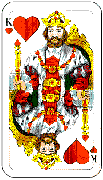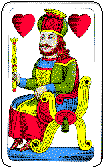Games played with German suited cards
The German suits of acorns ![]() , leaves
, leaves ![]() , hearts
, hearts ![]() and bells
and bells ![]() were established in the early fifteenth century. There may be some very early packs that had 52 cards, but at a fairly early stage the standard German pack came to consist of 48 cards. Each suit had a king, an upper jack (Obermann) with the suit symbol at the top, a lower jack (Untermann) with the suit symbol at the bottom, a ten (sometimes shown as a banner), and further numerals from nine down to two. Presumably this full 48 card pack was used for various games, but the main one about which we have information is Karnöffel.
were established in the early fifteenth century. There may be some very early packs that had 52 cards, but at a fairly early stage the standard German pack came to consist of 48 cards. Each suit had a king, an upper jack (Obermann) with the suit symbol at the top, a lower jack (Untermann) with the suit symbol at the bottom, a ten (sometimes shown as a banner), and further numerals from nine down to two. Presumably this full 48 card pack was used for various games, but the main one about which we have information is Karnöffel.
When the ace of the French and Italian packs was promoted to be the highest card in many games, the same thing happened to the two or deuce (Daus) of the German pack. Later, several games became popular in which the pack was shortened to 36, 32 or even fewer cards, by omitting what were now the lowest numerals: 3, 4, 5, sometimes 6, and so on. The deuce, now isolated as the highest card, has come to be thought of by most people as an ace, even though it has two suitmarks. In south Germany and Austria it is also often known as the sow (Sau).
German suited cards are still the primary type of cards used in many parts of central Europe. To some extent each country or region has its own variation of the pattern, with noticeably different designs. The main places where German suited cards are now used are as follows (please follow the links to the country pages for details of the games played).
|
|
|---|
Note on William Tell cards
The characters depicted on the kings, overs and unders are from the 15th century legend of Wilhelm Tell, who is supposed to have led the Swiss resistance against Austrian domination. According to the legend, he was compelled to shoot an arrow through an apple placed on his son's head. Specifically, the characters are from the play about Wilhelm Tell written by Friedrich Schiller in 1804.
The playing-cards with these characters became popular around the time of the revolutions of 1848, probably because of the parallels with the uprisings against the Habsburg empire. The cards are used mainly in Austria, Hungary, Slovakia, Slovenia and Romania, but are unknown in Switzerland, even though the characters on them are Swiss.
In North America, German suited cards can be obtained from TaroBear's Lair.



